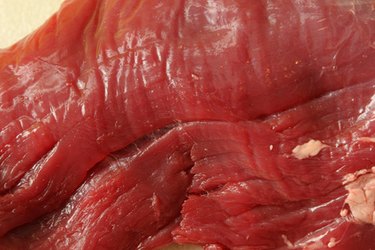
The beef tenderloin is one of the most naturally tender and leanest cuts of beef. These qualities, along with its mild flavor, make the tenderloin particularly desired by cooks and diners alike and the high demand for tenderloin is reflected in its high price. The tenderloin is a long, tapered, cylindrical muscle roughly 2 feet long and 5 inches at its widest diameter. The tenderloin spans two primal cuts of beef, the short loin and the sirloin.
Tenderloin Roast
Video of the Day
The whole uncut beef tenderloin is called the tenderloin roast. As the name implies, roasting is the preferred cooking method for the entire tenderloin. To ensure that the tenderloin roast cooks evenly, most recipes recommend that the thin tapered end of the tenderloin be folded under and tied with butcher's twine to produce a roast of uniform size and thickness. It is recommended that the tenderloin roast be cooked very rare, rare or medium rare, corresponding to an internal temperature in the range of 115°F–140°F (46°C–60°C). Overcooking any cut of the tenderloin defeats the purpose of paying a premium price for this tender cut of beef.
Video of the Day
Chateaubriand
There is an ongoing debate in the culinary world about what exactly the Chateaubriand cut is or whether it is properly a cut of beef or simply the namesake recipe. Generally speaking, if a cut of tenderloin in the butcher's case is called a Chateaubriand, it will look like a small roast or a thick steak cut from the center section of the tenderloin. Traditionally, the Chateaubriand recipe serves two people, so a Chateaubriand cut of tenderloin may be 3 to 5 inches thick and weigh 12 to 16 ounces.
Filet Mignon
Perhaps the most familiar cut of the beef tenderloin is the thick, single-portion steak called the filet mignon. French butchers are more specific than their American counterparts about the section of the tenderloin from which filet mignons are cut. French butchers cut filet mignon steaks exclusively from the smaller end of the tenderloin where the most tender meat is found. To American butchers, a filet mignon is a steak cut from any section of the tenderloin. Adding to the confusion, filet mignon may also be called fillet steak, beef filet, fillet de boeuf, tournedos, or simply tenderloin steak.
Porterhouse and T-Bone Steaks
Technically speaking, Porterhouse and T-bone steaks are not cuts of the beef tenderloin although each type of steak does include a portion of tenderloin along one side of the steak. Both types of steak are cut from beef short loin where the top loin and the tenderloin meet. Porterhouse steaks are cut farther back on the short loin where the tenderloin is thicker and, as a result, have a larger proportion of tenderloin than T-bone steaks.